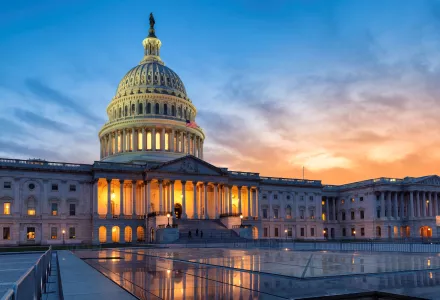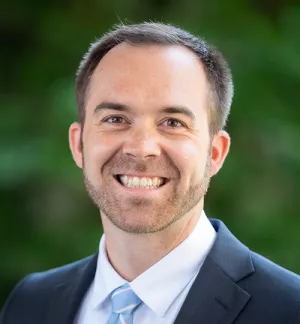
Executive Summary
The current generation of emerging technologies—artificial intelligence, synthetic biology tools, and more—is expected to change societies in profound ways as the tools mature and are increasingly used by governments, businesses, and individuals. The next generation of emerging technologies is primed to do the same.
How these technologies are developed, distributed, and managed will affect how societies reap their benefits and mitigate their costs. Together, we need to imagine the future of these technologies and plan ahead.
Societies will also need to look to the future to imagine future crises and the technologies that might protect against them, then fund the basic and applied research that could help these technologies come to fruition. For example, the first two COVID-19 vaccines to be widely distributed in the United States are mRNA vaccines, which rely on scientific discoveries funded by the federal government over decades.1 Some future crises, like the effects of climate change and the likelihood of future pandemics, are clear enough; others will require structured foresight. In either case, identifying the potential innovative new technologies that could ameliorate harm from these crises is vital.
How can United States policymakers better understand the next generation of emerging technologies and their societal implications? How can we make more educated decisions on the basic and applied research needed to solve the next generation of emerging threats?
The 117th Congress and the Biden Administration must urgently address these questions to protect the lives and livelihoods of those living in the United States.
A superficial understanding of emerging technologies and future crises is not enough for the legislative branch and Executive Office of the President (EOP) to appropriately evaluate and act on them in a timely manner. The pace of technological change, and the diffusion of innovation around the world, necessitates a deeper look at technologies and their implications for society.
This report will argue that the deeper look can and must come from the discipline of technology assessment, both in Congress and in the EOP. The discipline of technology assessment is a vital piece of the process of looking ahead; it is a powerful tool for surfacing the implications of critical or emerging technologies. When done well, technology assessment brings thoughtful policy options to decisionmakers for analysis and action.
What is Technology Assessment?
Technology assessment is not one thing; it is best thought of as a process designed to accomplish several goals.
First, at its most basic, technology assessment helps to provide objective, reliable technical information about a technology or issue.2 This information can then be absorbed and used by decision-makers to accomplish a task or further a goal.
Additionally, as Kathryn Wagner Hill notes, technology assessment “is best understood as a policy analysis process rather than a technical analysis…”3 In other words, a technology assessment is about more than the technology itself.
As Anthony Mills argues, technology assessment must use a broader lens to “understand and anticipate the nature and the ‘physical, biological, economic, social, or political effects’ of emerging technologies so that benefits may be reaped, and deleterious effects avoided or mitigated.”4
Indeed, as the seminal 1969 National Academies book on technology assessment, Technology: Processes of Assessment and Choice for the House Committee on Science and Astronautics, noted, technology assessment is ultimately about society: “Indeed, technology as such is not the subject of this report… Our subject, instead, is human behavior and institutions, and our purpose is not to conceive ways to curb or restrain or otherwise ‘fix’ technology but rather to conceive ways to discover and repair the deficiencies in the processes and institutions by which society puts the tools of science and technology to work.”5
Currently, the Government Accountability Office’s (GAO) Science, Technology Assessment, and Analytics (STAA) team conducts technology assessments for the legislative branch. In the EOP, technology assessment products are overseen by the Office of Science and Technology Policy (OSTP) and the President’s Council of Advisors on Science and Technology (PCAST).
With the start of a new Congress and a new presidential administration, now is the right time to refocus on technology assessment principles and recommit to the thorough analysis of critical and emerging technologies that is vital for crafting sound legislation, appropriating federal research and development dollars, and more.
Key Pillars of Effective Technology Assessment
When done right, technology assessment is a discipline that unearths insights and considers disparate perspectives on a technology and its potential impact on society.
Technology assessment is a process, not an outcome; a set of tools, not a solution.
While the legislative branch and the Executive Office of the President will necessarily create and use different structures to organize and oversee their technology assessment processes, each should incorporate four ‘pillars’ of effective technology assessment into their methodologies.
Pillars of Effective Technology Assessment
Strong Governance
The foundation of any technology assessment organization is strong governance, both at an institutional and a project level.
Responsive to Consumer Needs
Technology assessments must respond to the needs of the end user; they must “scratch real itches.”
Informed by Experts
Technical and non-technical experts from within and outside the federal government should be involved in technology assessments, including senior academics and leaders from private and not-for-profit sectors.
Policy Options, not Answers
Technology assessments should offer policy poptions, where appropriate, to help consumers reckon with the technology and its potential societal implications.
Strong Governance
The foundation of any technology assessment organization is strong governance.
Without a proper governance structure, the technology assessment organization will be threatened by internal and external issues. Internally, mismanagement could lead to the organization straying from its core mission, which could lead to poor performance or a failure to meet the needs of its customers. Externally, affected stakeholders could cast doubt on the effectiveness or authoritativeness of the organization, marshalling political forces to weaken it.
By pairing a permanent standing body capable of providing long-term guidance with short-term external advisory groups, the assessment organization can ensure continuity and expertise. This interlocking and reinforcing governance model allows flexibility and adaptability while keeping a core leadership team in place to create long-term stability and continuity.
Responsive to Consumer Needs
As a general principle, technology assessments should respond to the needs of the end user or the people directly impacted by the technology; they should “scratch real itches” that members of Congress and the President of the United States have. By understanding how the consumer views a problem and what they care about, the technology assessment body can create desired reports that will be used in the policymaking process.
This is not to say that the technology assessment body should never produce reports on topics before they are requested. As a discipline, foresight requires scanning the horizon for upcoming issues before they would reach the attention of policymakers. Additionally, technology assessments on unrequested topics could become valuable once the issue faces policymakers. In general, technology assessment organization governance bodies should carefully weigh the potential benefits and costs of technology assessments that are not requested.
Draw on Expertise from Within and Outside Government
Generally, technology assessments written with the input of a small group of in-house technical experts would run the risk of being seen as neither authoritative nor credible products because they would lack an external technical and non-technical perspective.
There is, of course, a great deal of technical expertise in the federal government, but inputs for technology assessments must come from a broad range of sources. Technical experts from both within and outside the federal government should be involved, including senior academics and leaders from private and not-for-profit sectors.
Practically, incorporating disparate perspectives into the process creates a better product, yielding a fuller view of a technology’s direct and indirect impacts on society and validating the assessment body’s expertise. Incorporating more voices—including contradictory voices—reduces groupthink and makes space for new ideas, and potentially including public comment processes would enable even more voices to be heard. Importantly, a broader set of inputs can ensure what the writer James Fallows refers to as a “tragic imagination”—visualizing and understanding what could go wrong with the technology or as a result of the technology’s use.
Offer Policy Options, Not Answers
A technology assessment is not an argument for a specific policy or set of policies, or the answer to a policy problem.
Instead, a technology assessment should offer policy options, where appropriate, to help policymakers reckon with the technology and its potential implications. A technology assessment should be an important input into the policymaking process without deciding on the “right” option—a task best left to elected officials, who are best suited to represent their constituencies’ needs and values as they weigh various policy options.
Practically, members of Congress do not want answers from a technology assessment body, because it is their responsibility to come up with the answers. Legislation that is grounded in the analyses of legislative committees and individual members—and supported by a thorough technology assessment—will be stronger and more likely to pass, as it will be responsive not only to an analysis of the technology but also to constituents. Politically, this ensures that the technology assessment body serves as a resource, not a rival.
Considerations for the 117th Congress and the Biden Administration
Both the 117th Congress and President Biden’s Executive Office of the President have bodies working within them that conduct technology assessments. Each is discussed below, along with considerations for how to tackle the process of technology assessment today.
Congressional Technology Assessment
Currently, the Government Accountability Office’s Science, Technology Assessment, and Analytics team conducts and oversees technology assessments for Congress.
The STAA attempts to incorporate most of the four pillars of effective technology assessment discussed in the previous section. The STAA has a clear governance structure for technology assessments; is responsive to the needs of Congress, as it only conducts assessments as a result of a congressional request; brings in internal and external expertise, casting a wide net for advice as it builds its products; and offers policy options where it believes them to be appropriate.
As the STAA deepens its technology assessment capabilities and refines its processes, it should consider the following:
Governance
To further build a relationship with Congress, the STAA should develop a broader governing body for its technology assessments that includes members of Congress and gives them an opportunity to weigh in on both the process and content of technology assessments.
Autonomy
Congress should consider several substantive changes to how the STAA is governed and funded.
Expertise
Even as the STAA should continue to rely on external non-technological expertise to develop an understanding of the societal implications of a given technology, it should also consider bolstering its internal expertise in these areas. As its team continues to grow, the STAA should prioritize non-technological expertise, in areas including, but not limited to, ethics, sociology, and law.
Consultation
To offer value to a broader group of members, STAA should consider prioritizing requests on short-term products from any member of Congress. While the GAO’s congressional protocols allow for requests from individual members, they are lowest on its list of priorities and, in practice, have not had requests answered in years.
Executive Office of the President
The EOP has several bodies that advise it on science and technology issues, including the Office of Science and Technology Policy and the President’s Council of Advisors on Science and Technology. As the new team begins to plan for their work, they should consider the following:
Selectivity
The OSTP and the PCAST should be selective in the range of topics they conduct broad analyses on. While there are myriad worthy topics, the EOP should task the PCAST with a limited number of topics to focus on.
Coordination
Relatedly, experts argue that the OSTP, the PCAST, and the Office of Management and Budget need to coordinate on setting research priorities.
Flexibility
The PCAST should have the resources necessary to adapt to crises that occur.
Attention
President Biden’s time is the most precious resource in the executive branch, and what Biden and his top advisers focus on carries a great deal of weight. It is critical, then, that the PCAST be able to engage directly with the president.
What’s Needed to Put Technology Assessment to Good Use
Both the legislative branch and the EOP need science and technology capacity to realize the full value of technology assessments conducted for them. Technology assessment does not exist in a vacuum; it must be interpreted, summarized, analyzed, discussed, and debated before being used in the policymaking processed.
In previous reports, the Technology and Public Purpose (TAPP) Project has investigated Congress’s science and technology capacity and offered recommendations for the legislative branch.
This report will not go into detail about all the different ways that Congress could address its STEM capacity issues, but three components are worth addressing: the need for rapid response STEM capacity, the need for additional STEM expertise in personal offices and committees, and Congress’s need for greater overall capacity.
Additional STEM Expertise for Rapid Response Capacity
Congress needs a resource for rapid-turnaround synthesis and analysis of science and technology issues.
As discussed in Building a 21st Century Congress: Improving Congress’s Science and Technology Expertise, congressional staffers rely on committee staff to serve as go-to resources for quick answers on science and technology topics, but a dedicated resource would allow for additional requests to be met and for committee staff to spend more time on committee work.
Additional STEM Expertise in Personal Offices and On Committees
As an institution, Congress is not structurally designed to support bringing individuals with STEM backgrounds in as policy advisers—though there are, of course, several STEM experts who offer policy advice on Capitol Hill.
Congressional staffers are overworked and underpaid; institutional underfunding means that most staffers are generalists who handle a broad portfolio of issues. Personal offices and committees prioritize experience working on Capitol Hill for policy roles; individuals with PhDs in STEM subjects usually do not have that background.
While several highly regarded fellowships are designed to give STEM experts an opportunity to advise Congress on science and technology policy, they are time-limited by nature and cannot fill the significant STEM capacity gap in Congress.
Adding STEM expertise in personal offices and committees would allow for better and more rapid analysis of technology assessments and other technical information. In Building a 21st Century Congress: Improving STEM Policy Advice in the Emerging Technology Era, we included several options for doing so:
Additional Investment in Congress’s Overall Capacity
More broadly, Congress needs to invest in itself by increasing its budget, which would allow members to hire more staffers and pay them better. This, in turn, would help Congress attract and retain more subject matter experts and give more junior staffers opportunities to stick around and become subject matter experts, if they wish to do so.
Conclusion
Had the United States Congress not defunded the Office of Technology Assessment in 1996, would the past 25 years of science and technology legislation look any different?
Would Congress, having foreseen the societal implications of large social media companies, acted earlier to mitigate their harms? How might pandemic preparedness have been addressed after several near misses? How might climate have been addressed earlier?
Counterfactuals are hard, and we cannot know for certainty that anything would be different. The same forces that led to the defunding of the OTA would still be with us; political considerations still weigh heavy on the legislative process. Funding would remain a constraint, too; perhaps, even recognizing the issues laid out by exhaustive technology assessments, conservative members of Congress would still balk at raising taxes to support a more robust public health system or to invest in green technologies designed to reduce dependence on fossil fuels. Structural problems require structural solutions, and the OTA is but one component of a broader solution.
And yet, with more acute and chronic crises facing the American public, it is vital to ask: is this the best we can do? Is this the most we should expect from the United States Congress?
For our future, and for the sake of generations to come, we must demand more from our elected representatives. Recommitting to the basic principles and structures of technology assessment is one way for Congress to show it is up to the task of legislating for the 21st century.
Similarly, the Biden Administration should continue to focus on hiring and deploying scientists and technologists to identify, research, and explain emerging technologies to policymakers—and to lead the organizations where those priorities will be enacted.
The next generation of technologies will be transformative; it is up to us to make sure that they help make the world healthier, happier, and more prosperous.
Download the full version:
Executive Summary Footnotes
1 Arthur Allen, “For Billion-Dollar COVID Vaccines, Basic Government-Funded Science Laid the Groundwork,” Scientific American, November 2020, https://www.scientificamerican.com/article/for-billion-dollar-covid-vaccines-basic-government-funded-science-laid-the-groundwork/.
2 M Anthony Mills, “The Many Meanings of ‘Technology Assessment,’” February 2020, 8, https://lincolnpolicy.org/wp-content/uploads/2020/02/MILLS.pdf.
3 Kathryn Wagner Hill, “A New-Old Vision for Congressional Technology Assessment,” February 2020, 5, https://lincolnpolicy.org/wp-content/uploads/2020/02/HILL.pdf.
4 Mills, “The Many Meanings of ‘Technology Assessment.’”
5 Technology: Processes of Assessment and Choice. (Committee on Science and Astronautics, U.S. House of Representatives: National Academy of Sciences, 1969), 15, https://doi.org/10.17226/21060.
Miesen, Mike and Laura Manley. “Building a 21st Century Congress: A Playbook for Modern Technology Assessment .” June 2021








